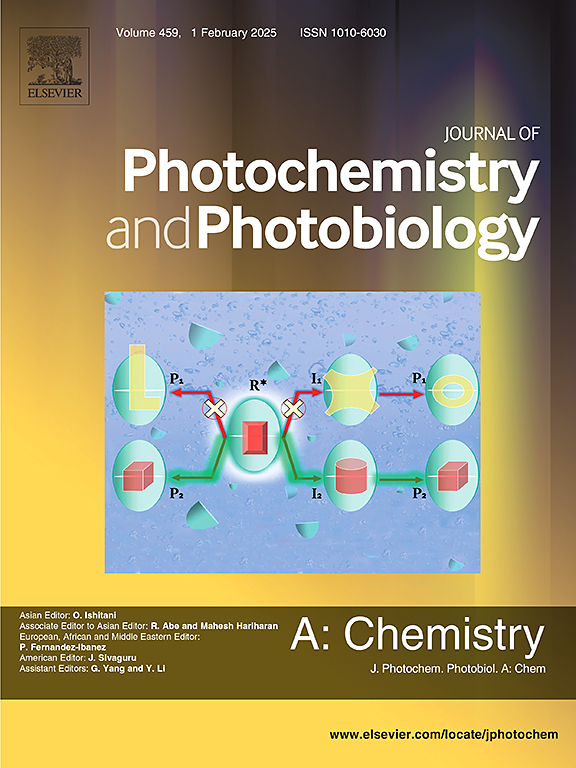Enhanced photoactivity performance of CeO2 and CuO modified TiO2 nanotube arrays
IF 4.1
3区 化学
Q2 CHEMISTRY, PHYSICAL
Journal of Photochemistry and Photobiology A-chemistry
Pub Date : 2025-05-31
DOI:10.1016/j.jphotochem.2025.116529
引用次数: 0
Abstract
TiO2 nanotube arrays (TiO2-NT) were synthesized by electrochemical anodization and modified with 1, 3 and 5 mM Ce(III) or Cu(II) by chemical deposition. The catalysts were characterized by scanning electron microscopy, X-ray diffraction, AFM analysis, and electrochemical techniques. The presence of Ce and Cu species was confirmed by slight shifts in the main TiO2 diffraction peaks, suggesting the incorporation of Ce and Cu into the TiO2 lattice, since some characteristic peaks of these oxides overlap with those of the predominant anatase phase. The catalyst samples displayed a well-defined morphology, with a nanotube length of 8.5–10.1 μm and an average NT-TiO2 internal diameter of 54–112 nm. Higher anodic oxidation photocurrent densities were obtained compared to the unmodified TiO2 sample, such as 340 μA/cm2 for CeO2-TiO2-NT, 315 μA/cm2 for CuO-TiO2-NT and 60 μA/cm2 for TiO2-NT under UV at the highest metal oxide concentration. Furthermore, 5 mM-CeO2-TiO2-NT showed good stability during reuse, without appreciable deactivation of its photocatalytic performance. The photocatalytic performance of the catalyst samples was studied by the degradation of acetaminophen (AC) at neutral pH. The degradation of AC under UV and sunlight increased with increasing metal oxide concentration in the TiO2 nanostructure. Complete AC degradation was achieved with ≤ 50 µmol L−1 AC at ≤ 75 min.
CeO2和CuO修饰TiO2纳米管阵列的光活性增强
采用电化学阳极氧化法制备了TiO2纳米管阵列(TiO2- nt),并分别用1、3、5 mM Ce(III)或Cu(II)进行化学沉积修饰。通过扫描电子显微镜、x射线衍射、原子力显微镜分析和电化学技术对催化剂进行了表征。由于Ce和Cu氧化物的一些特征峰与主要锐钛矿相的特征峰重叠,因此在TiO2晶格中存在Ce和Cu两种物质。催化剂样品形貌清晰,纳米管长度为8.5 ~ 10.1 μm,平均内径为54 ~ 112 nm。与未修饰的TiO2样品相比,在最高金属氧化物浓度下,CeO2-TiO2-NT的阳极氧化光电流密度为340 μA/cm2, CuO-TiO2-NT为315 μA/cm2, TiO2- nt为60 μA/cm2。此外,5 mM-CeO2-TiO2-NT在重复使用过程中表现出良好的稳定性,没有明显的光催化性能失活。通过在中性ph下对乙酰氨基酚(AC)的降解研究了催化剂样品的光催化性能。随着TiO2纳米结构中金属氧化物浓度的增加,在紫外和日光下对AC的降解能力增强。在≤50µmol L - 1 AC条件下,在≤75 min的时间内实现了完全的AC降解。
本文章由计算机程序翻译,如有差异,请以英文原文为准。
求助全文
约1分钟内获得全文
求助全文
来源期刊
CiteScore
7.90
自引率
7.00%
发文量
580
审稿时长
48 days
期刊介绍:
JPPA publishes the results of fundamental studies on all aspects of chemical phenomena induced by interactions between light and molecules/matter of all kinds.
All systems capable of being described at the molecular or integrated multimolecular level are appropriate for the journal. This includes all molecular chemical species as well as biomolecular, supramolecular, polymer and other macromolecular systems, as well as solid state photochemistry. In addition, the journal publishes studies of semiconductor and other photoactive organic and inorganic materials, photocatalysis (organic, inorganic, supramolecular and superconductor).
The scope includes condensed and gas phase photochemistry, as well as synchrotron radiation chemistry. A broad range of processes and techniques in photochemistry are covered such as light induced energy, electron and proton transfer; nonlinear photochemical behavior; mechanistic investigation of photochemical reactions and identification of the products of photochemical reactions; quantum yield determinations and measurements of rate constants for primary and secondary photochemical processes; steady-state and time-resolved emission, ultrafast spectroscopic methods, single molecule spectroscopy, time resolved X-ray diffraction, luminescence microscopy, and scattering spectroscopy applied to photochemistry. Papers in emerging and applied areas such as luminescent sensors, electroluminescence, solar energy conversion, atmospheric photochemistry, environmental remediation, and related photocatalytic chemistry are also welcome.

 求助内容:
求助内容: 应助结果提醒方式:
应助结果提醒方式:


